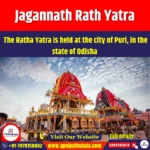Jagannath Rath Yatra
General Studies Paper I: Temple Architecture |
Why in News?
Recently, the Jagannath Rath Yatra began on June 27, 2025, marking the start of a nine-day festival in Puri, Odisha. It will conclude on July 5, 2025, with Niladri Bijay.
Introduction to Jagannath Rath Yatra
- What is the Rath Yatra?
- Rath Yatra means “Chariot Festival” in Sanskrit.
- It marks the ceremonial journey of Lord Jagannath, Lord Balabhadra, and Devi Subhadra.
- Every year, the three deities ride large wooden chariots to Gundicha Temple, located nearly 3 kilometers from the main Jagannath Temple.
- The Jagannath Temple in Puri is the main center of this festival.
- The temple is one of the Char Dham pilgrimage sites for Hindus.
- The journey symbolizes a divine visit to their maternal aunt’s house.
- Devotees believe pulling the chariots brings spiritual blessings.
- Where and When It Happens?
- The festival is celebrated in Puri, a coastal city in Odisha, India.
- It begins on the second day of the bright fortnight of Ashadha month in the Hindu calendar.
- This usually falls in June or July.
- The event continues for 9 days. It ends with the return journey, known as Bahuda Yatra.
Mythological Reason of Jagannath Rath Yatra
- Historical Roots:
- The tradition of Rath Yatra dates back to several centuries, with documented references available from the 12th century, when King Anantavarman Chodaganga Deva of the Eastern Ganga dynasty constructed the Jagannath Temple in Puri. The ritual of the chariot journey has continued as an annual tradition since its early beginning.
- The practice finds its earliest mentions in the Skanda Purana, Brahma Purana, and other scriptures, which describe the rituals connected to Lord Jagannath.
- According to temple customs, the deities come out of the sanctum once a year to give darshan to everyone, especially those who are not allowed inside the temple.
- Visit to Aunt’s Home:
- According to Vaishnava tradition, the Rath Yatra marks the yearly visit of Lord Jagannath, Lord Balabhadra, and Devi Subhadra to their maternal aunt’s house, which is the Gundicha Temple.
- This journey is believed to fulfill a promise made by the Lord to His aunt.
- For seven days, the deities stay there before returning to their main temple.
Rituals and Preparations Before the Yatra
- Snana Yatra:
- The ritual journey begins with Snana Yatra, which takes place on the Purnima (full moon) day of the Jyeshta month in the Hindu calendar.
- On this day, the three main deities—Jagannath, Balabhadra, and Subhadra—are brought out of the sanctum to the Snana Mandap, a special platform inside the temple premises.
- Inside the temple, priests pour 108 pots of sacred water from the Golden Well, known as Suna Kua, to bathe each deity before the festival.
- After this ceremony, the deities are believed to fall ill and rest in isolation. This period is called Anasara, which lasts for about 15 days.
- Chariots:
- Building the three grand chariots is a major part of the preparation.
- The process starts on Akshaya Tritiya, a sacred day in April or May.
- The temple administration selects special Neem trees, called Daru, to use for the construction.
- Only designated families of carpenters, known as Maharana and Bhoi servitors, build the chariots by following strict guidelines found in centuries-old temple records.
- Each deity has a unique chariot.
Features of Jagannath Rath Yatra’s Chariots
- Jagannath’s Chariot:
- The chariot used for Lord Jagannath during the procession is called Nandighosha.
- It is the tallest among the three and reaches a height of around 45 feet (13.7 meters).
- It has 16 wooden wheels, each measuring about 6 feet in diameter.
- The color of the canopy is red and yellow, which holds religious significance.
- The front of the chariot displays figures of Garuda, the divine bird who serves Lord Vishnu.
- Balabhadra Chariots:
- Lord Balabhadra travels on his distinct chariot, which is called Taladhwaja.
- This chariot has 14 wheels and stands about 44 feet tall.
- The canopy covering this chariot features a blend of green and red fabric.
- The wooden horses pulling this chariot are black and named Tivra, Ghora, Dirghasharma, and Swarnanava.
- Subhadra’s Chariots:
- Devi Subhadra travels in her chariot named Darpadalana.
- It has 12 wheels and is about 43 feet in height.
- The canopy is colored red and black, which signifies protection and power.
- The four horses pulling her chariot are red in color and named Rochika, Mochika, Jita, and Aparajita.
- The charioteer placed at the front is called Arjuna.
All Nine Days Rituals of Jagannath Rath Yatra
- Day One: On the first day, Lord Jagannath, Lord Balabhadra, and Devi Subhadra leave the main temple. Priests place each deity on their respective chariots in a ceremony called Pahandi Bije.
- The Gajapati King of Puri performs Chhera Pahara, a sweeping ritual with a golden broom.
- Devotees then pull the three massive chariots through the streets of Puri.
- The chariots head towards the Gundicha Temple.
- Day Two: Once the chariots reach Gundicha Temple, the deities enter their new abode. They stay in this temple for a week.
- Day Three: On the third day, devotees gather in large numbers for the evening darshan. Priests perform special pujas.
- Day Four: The deities continue to rest inside Gundicha Temple. Priests perform regular seva and offer bhog (sacred food) to the deities.
- Day Five: On the fifth day after the Rath Yatra, Goddess Lakshmi visits Gundicha Temple in a ritual known as Hera Panchami, where she searches for Lord Jagannath.
- Day Six: This day is meant for reflection and spiritual silence. Devotees use this time for personal prayers and meditation.
- Day Seven: On this day, priests begin preparing the deities for the return trip known as Bahuda Yatra.
- Day Eight: The chariots move from Gundicha Temple back to the main Jagannath Temple. This journey is called Bahuda Yatra. It follows the same path as the onward journey.
- Day Nine: The ninth day marks the most awaited ritual called Suna Besha.
- During this event, the deities appear in golden attire, wearing crowns and various pieces of jewelry while seated on their chariots.
- After the darshan, the deities return inside the temple in a ritual called Niladri Bije.
Unique Features of the Jagannath Temple
- The temple showcases Kalinga architecture, which is specific to Odisha. It includes four distinct parts: Vimana (sanctum), Jagamohana (assembly hall), Nata Mandapa (dancing hall), and Bhoga Mandapa (offering hall).
- The temple’s main tower rises about 65 meters high. A chakra (wheel) made of eight metals, known as Sudarshan Chakra, crowns this tower.
- The temple operates the world’s largest open kitchen, called the Rosa Ghara, which can prepare food for over 100,000 people daily.
- The temple structure casts no shadow on the ground at any time of day.
- The temple is also referred to as Yamanika Tirtha, where Lord Jagannath is believed to stop Yama, the god of death, from entering the holy city.
- The idols are made from sacred Neem wood, which is replaced every 12 to 19 years in a ritual called Nabakalebara.
- The Shree Jagannath Temple Administration, or SJTA, looks after the temple’s affairs under the rules set by the Jagannath Temple Act of 1955.









